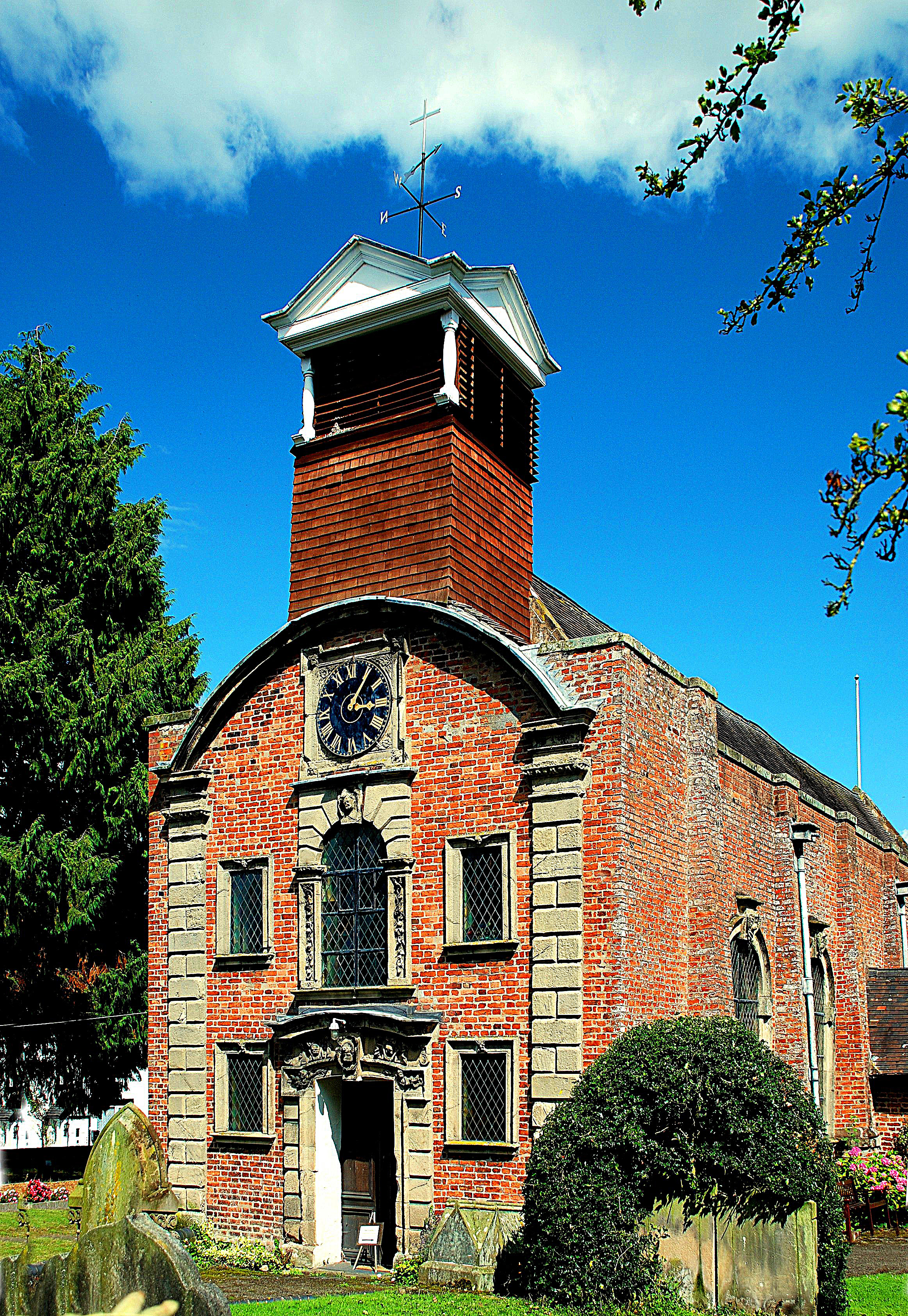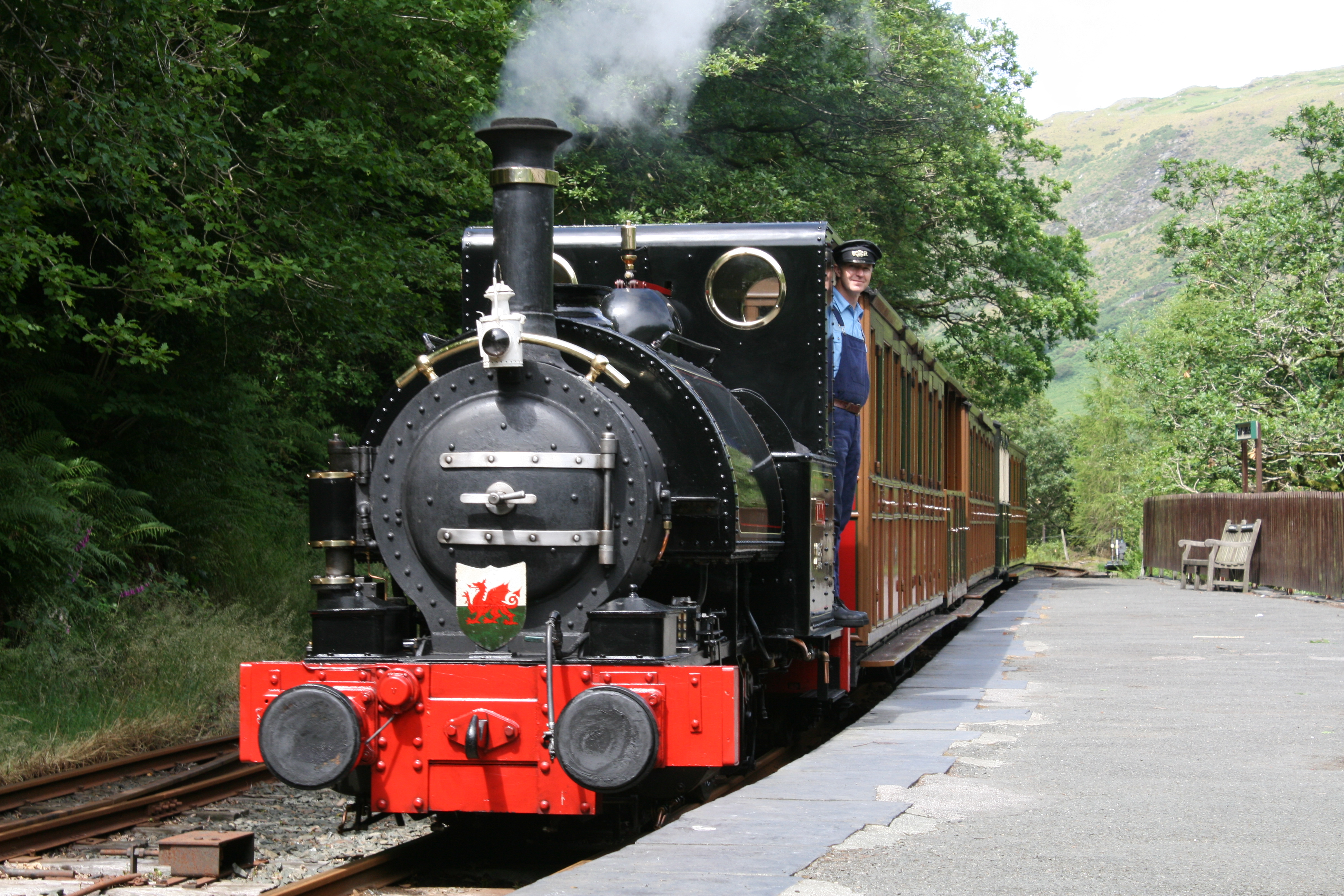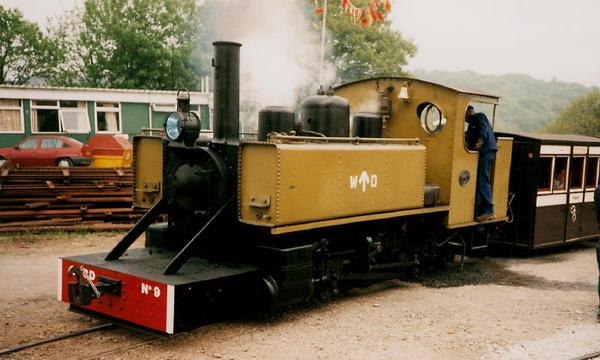|
Snailbeach District Railways
Snailbeach District Railways was a British narrow gauge railway in Shropshire. It was built to carry lead ore from mines in the Stiperstones to Pontesbury where the ore was transshipped to the Great Western Railway's Minsterley branch line. Coal from the Pontesford coal mines travelled in the opposite direction. The line ended at Snailbeach, the location of Shropshire's largest and richest lead mine, though there had been a plan to extend it further, which would have brought it closer to more lead mines. History The railway was incorporated by Act of Parliament on 5 August 1873 and opened in 1877. It was built with an unusual gauge of . The line was prosperous at first, carrying annually and paying a 3% dividend. However, in 1884, the Tankerville Great Consols Company mine, the largest user of the railway, closed, and tonnage fell to . In 1905, the Ceirog Granite Company opened a quarry near Habberley, and a branch was built to serve this. An extra locomotive was require ... [...More Info...] [...Related Items...] OR: [Wikipedia] [Google] [Baidu] |
Narrow Gauge Railway
A narrow-gauge railway (narrow-gauge railroad in the US) is a railway with a track gauge narrower than standard . Most narrow-gauge railways are between and . Since narrow-gauge railways are usually built with tighter curves, smaller structure gauges, and lighter rails, they can be less costly to build, equip, and operate than standard- or broad-gauge railways (particularly in mountainous or difficult terrain). Lower-cost narrow-gauge railways are often used in mountainous terrain, where engineering savings can be substantial. Lower-cost narrow-gauge railways are often built to serve industries as well as sparsely populated communities where the traffic potential would not justify the cost of a standard- or broad-gauge line. Narrow-gauge railways have specialised use in mines and other environments where a small structure gauge necessitates a small loading gauge. In some countries, narrow gauge is the standard; Japan, Indonesia, Taiwan, New Zealand, South Africa, and the Aust ... [...More Info...] [...Related Items...] OR: [Wikipedia] [Google] [Baidu] |
Track Gauge
In rail transport, track gauge (in American English, alternatively track gage) is the distance between the two rails of a railway track. All vehicles on a rail network must have wheelsets that are compatible with the track gauge. Since many different track gauges exist worldwide, gauge differences often present a barrier to wider operation on railway networks. The term derives from the metal bar, or gauge, that is used to ensure the distance between the rails is correct. Railways also deploy two other gauges to ensure compliance with a required standard. A '' loading gauge'' is a two-dimensional profile that encompasses a cross-section of the track, a rail vehicle and a maximum-sized load: all rail vehicles and their loads must be contained in the corresponding envelope. A ''structure gauge'' specifies the outline into which structures (bridges, platforms, lineside equipment etc.) must not encroach. Uses of the term The most common use of the term "track gauge" refers to the ... [...More Info...] [...Related Items...] OR: [Wikipedia] [Google] [Baidu] |
Wayleave
An easement is a nonpossessory right to use and/or enter onto the real property of another without possessing it. It is "best typified in the right of way which one landowner, A, may enjoy over the land of another, B". An easement is a property right and type of incorporeal property in itself at common law in most jurisdictions. An easement is similar to real covenants and equitable servitudes. In the United States, the Restatement (Third) of Property takes steps to merge these concepts as servitudes. Easements are helpful for providing access across two or more pieces of property, allowing individuals to access other properties or a resource, for example to fish in a privately owned pond or to have access to a public beach. The rights of an easement holder vary substantially among jurisdictions. Types Historically, common law courts would enforce only four types of easement: * Right-of-way (easements of way) * Easements of support (pertaining to excavations) * Easeme ... [...More Info...] [...Related Items...] OR: [Wikipedia] [Google] [Baidu] |
Shropshire Council
Shropshire Council is the local authority of Shropshire (district), Shropshire, in England, comprising the ceremonial county of Shropshire except Telford and Wrekin. It is a Unitary authorities of England, unitary authority, having the powers of a non-metropolitan county and district council combined. It replaced the former two-tier local government structure in the non-metropolitan county of Shropshire on 1 April 2009, which involved its immediate predecessor, Shropshire County Council, and five non-metropolitan district councils – Bridgnorth District Council, North Shropshire District Council, Oswestry Borough Council, Shrewsbury and Atcham Borough Council and South Shropshire District Council. These districts and their councils were abolished in the reorganisation. The area covered by Shropshire Council is , which is 91.7% of the Ceremonial counties of England, ceremonial county of Shropshire. The remainder of the county is covered by Telford and Wrekin Council, which was ... [...More Info...] [...Related Items...] OR: [Wikipedia] [Google] [Baidu] |
Minsterley
Minsterley is a village and civil parish in Shropshire, England. In the 2011 census, its population was 1,777. Minsterley lies one mile south-west of Pontesbury and 10 miles south-west of Shrewsbury. East from Minsterley along the A488, is the larger village of Pontesbury and to its south the hill range, the Stiperstones. The Rea Brook flows nearby and the smaller Minsterley Brook flows through the centre of the village. Little Minsterley is a hamlet on the northeastern edge of the village, which was founded in 1901. Between it and the main village is located one of the Shropshire Fire and Rescue Service's retained fire stations. Governance Until the 19th century, Minsterley was part of the parish of Westbury, hence its description under Westbury in John Marius Wilson's ''Imperial Gazetteer of England and Wales'' (1870–72) like this: : "WESTBURY,... parish includes Minsterley chapelry, and forms a sub-district. Acres, 11,274....The p rpetual curacy of Minsterley is a separat ... [...More Info...] [...Related Items...] OR: [Wikipedia] [Google] [Baidu] |
Rusting Rails
Rust is an iron oxide, a usually reddish-brown oxide formed by the reaction of iron and oxygen in the catalytic presence of water or air moisture. Rust consists of hydrous iron(III) oxides (Fe2O3·nH2O) and iron(III) oxide-hydroxide (FeO(OH), Fe(OH)3), and is typically associated with the corrosion of refined iron. Given sufficient time, any iron mass, in the presence of water and oxygen, could eventually convert entirely to rust. Surface rust is commonly flaky and friable, and provides no passivational protection to the underlying iron, unlike the formation of patina on copper surfaces. ''Rusting'' is the common term for corrosion of elemental iron and its alloys such as steel. Many other metals undergo similar corrosion, but the resulting oxides are not commonly called "rust". Several forms of rust are distinguishable both visually and by spectroscopy, and form under different circumstances. Other forms of rust include the result of reactions between iron and chloride i ... [...More Info...] [...Related Items...] OR: [Wikipedia] [Google] [Baidu] |
Tarmac Limited
Tarmac is a British building materials company headquartered in Solihull, England. The company was formed as Lafarge Tarmac in March 2013, by the merger of Anglo American's Tarmac UK and Lafarge's operations in the United Kingdom. In July 2014, Anglo American agreed to sell its stake to Lafarge, to assist Lafarge in its merger with Holcim and allay competition concerns. Prior to 1999, Tarmac Plc was an aggregates to construction company dating from 1903. It was demerged in July 1999, with the Construction and Professional services arms forming Carillion plc. The aggregates and building materials side of the business retained the Tarmac name and was bought by Anglo American shortly afterwards. In February 2015, Lafarge announced that the business would be sold to CRH plc, once Anglo American had sold its stake. Anglo American completed the sale in July 2015, and the acquisition by CRH completed the following month. Following the purchase, Lafarge Tarmac was rebranded as Tarma ... [...More Info...] [...Related Items...] OR: [Wikipedia] [Google] [Baidu] |
Talyllyn Railway
The Talyllyn Railway ( cy, Rheilffordd Talyllyn) is a narrow gauge preserved railway in Wales running for from Tywyn on the Mid-Wales coast to Nant Gwernol near the village of Abergynolwyn. The line was opened in 1865Drummond 2015, page 17 to carry slate from the quarries at Bryn Eglwys to Tywyn, and was the first narrow gauge railway in Britain authorised by Act of Parliament to carry passengers using steam haulage. Despite severe under-investment, the line remained open, and in 1951 it became the first railway in the world to be preserved as a heritage railway by volunteers. Since preservation, the railway has operated as a tourist attraction, expanding its rolling stock through acquisition and an engineering programme to build new locomotives and carriages. In 1976, an extension was opened along the former mineral line from Abergynolwyn to the new station at Nant Gwernol. In 2005 a major rebuilding and extension of Tywyn Wharf station took place, including a much-expande ... [...More Info...] [...Related Items...] OR: [Wikipedia] [Google] [Baidu] |
Fordson Tractor
Fordson was a brand name of tractors and trucks. It was used on a range of mass-produced general-purpose tractors manufactured by Henry Ford & Son Inc from 1917 to 1920, by Ford Motor Company (U.S.) and Ford Motor Company Ltd (U.K.) from 1920 to 1928, and by Ford Motor Company Ltd (U.K.) from 1929 to 1964. The latter (Ford of Britain) also later built trucks and vans under the Fordson brand. After 1964, the Fordson name was dropped and all Ford tractors were simply badged as Fords in both the UK and the US. Production years Between 1917 and 1922, the Fordson was for tractors somewhat like the Ford Model T was for automobiles—it captured the public's imagination and widely popularized the machine, with a reliable design, a low price affordable for workers and farmers, a widespread dealership network, and a production capacity for large numbers. Just as the Model T helped the public to appreciate how soon cars and trucks might replace most horses in transport, the Fordson helpe ... [...More Info...] [...Related Items...] OR: [Wikipedia] [Google] [Baidu] |
Shropshire County Council
Shropshire County Council was the county council of the non-metropolitan county of Shropshire in England. History The Council came into its powers under the Local Government Act 1888 on 1 April 1889 and was known as Salop County Council from formation until 1 April 1980. It was based at the Old Shirehall in Market square, Shrewsbury until it moved to the new Shirehall in Abbey Foregate in Shrewsbury in 1966. Wrekin unitary The area covered by the council was decreased in 1998 when the Telford and Wrekin unitary authority was created, removing The Wrekin district from the non-metropolitan county of Shropshire. County unitary The county council was replaced, along with the county's five district councils, by a unitary authority called Shropshire Council on 1 April 2009. However, as the 'continuing authority', the councillors of the county council became the councillors of the new authority for the interim period until the first elections to Shropshire Council were held on 4 Ju ... [...More Info...] [...Related Items...] OR: [Wikipedia] [Google] [Baidu] |
Steam Locomotives
A steam locomotive is a locomotive that provides the force to move itself and other vehicles by means of the expansion of steam. It is fuelled by burning combustible material (usually coal, oil or, rarely, wood) to heat water in the locomotive's boiler to the point where it becomes gaseous and its volume increases 1,700 times. Functionally, it is a steam engine on wheels. In most locomotives, the steam is admitted alternately to each end of its cylinders, in which pistons are mechanically connected to the locomotive's main wheels. Fuel and water supplies are usually carried with the locomotive, either on the locomotive itself or in a tender coupled to it. Variations in this general design include electrically-powered boilers, turbines in place of pistons, and using steam generated externally. Steam locomotives were first developed in the United Kingdom during the early 19th century and used for railway transport until the middle of the 20th century. Richard Trevithick bui ... [...More Info...] [...Related Items...] OR: [Wikipedia] [Google] [Baidu] |
War Department Light Railways
The War Department Light Railways were a system of narrow gauge trench railways run by the British War Department in World War I. Light railways made an important contribution to the Allied war effort in the First World War, and were used for the supply of ammunition and stores, the transport of troops and the evacuation of the wounded. Track gauges Different track gauges were used in different parts of the world including 600mm, , and . The military light railways in France were of gauge and used a variety of steam and petrol locomotives from French, British and American builders. The Germans installed their gauge Feldbahn system early in the war. Trench railways of the World War I western front produced the greatest concentration of minimum-gauge railway locomotives observed to date. Development Britain came to the belated realisation that it needed a flexible and reliable method of supplying the front lines, bringing shells, timber, and fodder from the rear areas an ... [...More Info...] [...Related Items...] OR: [Wikipedia] [Google] [Baidu] |







